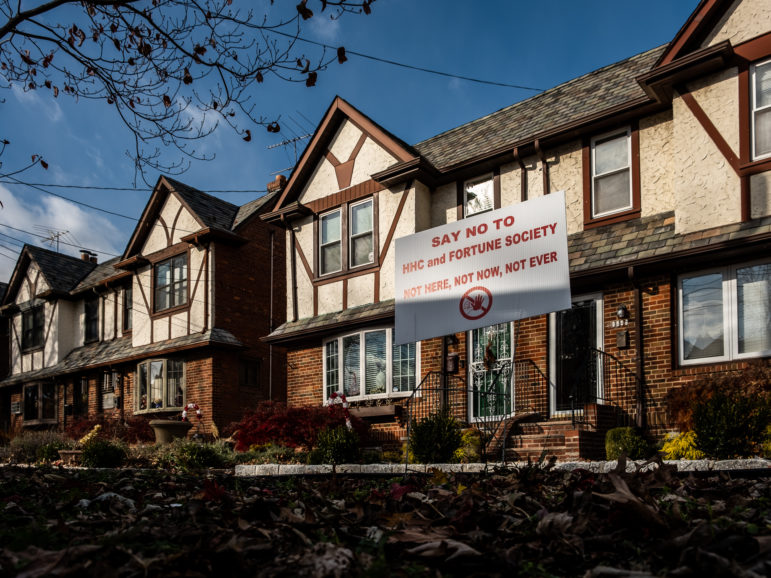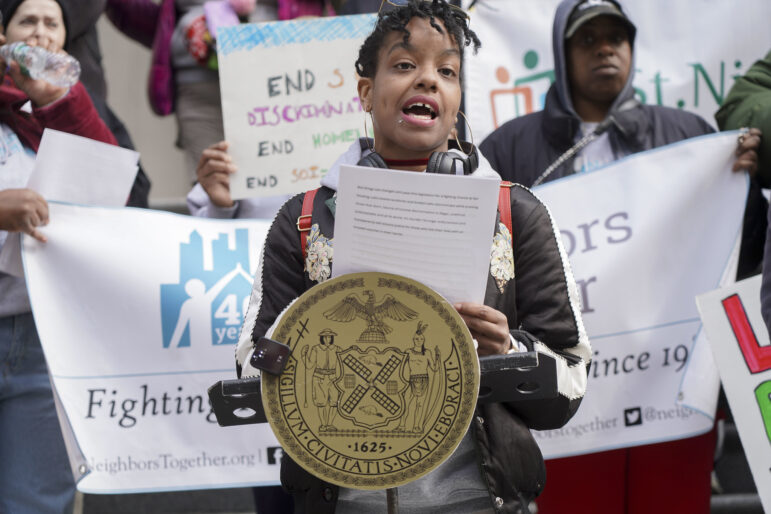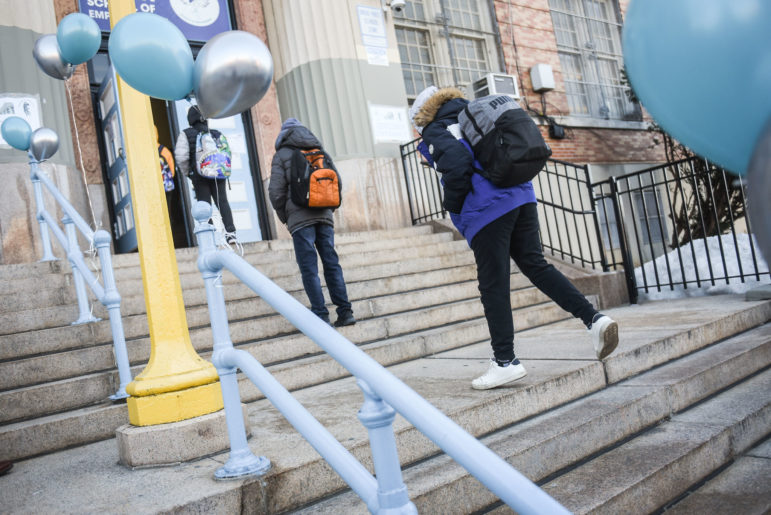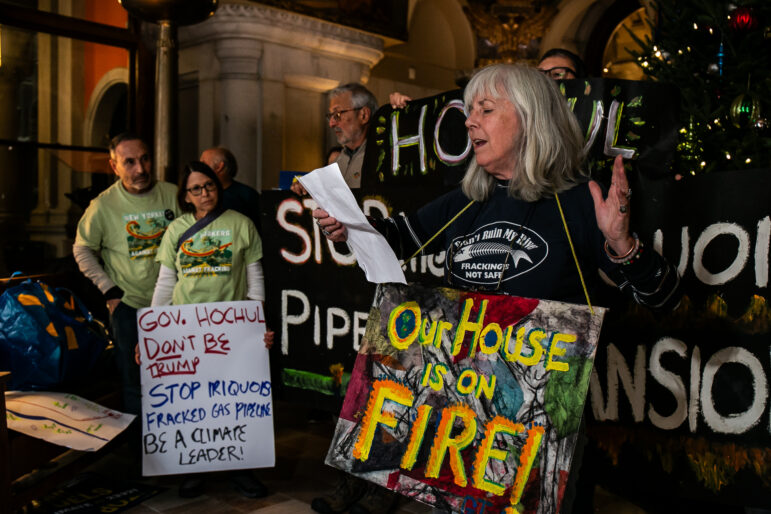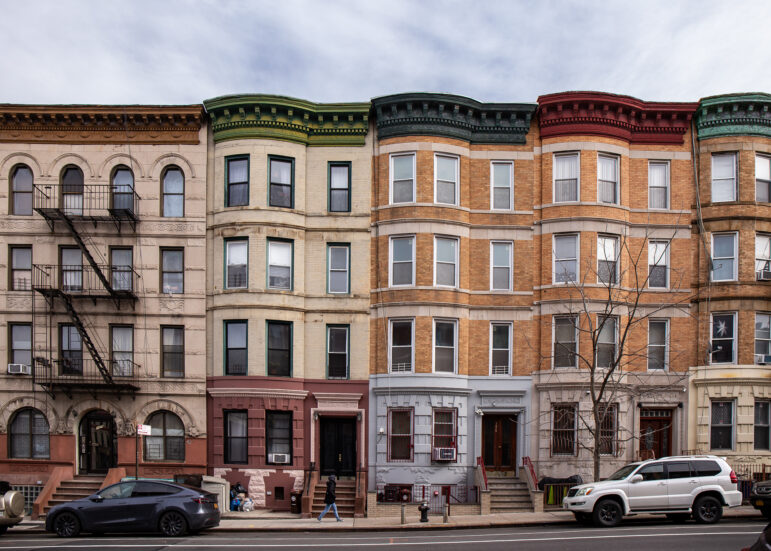Since the Climate Leadership and Community Protection Act was signed into law in 2019, laying out aggressive benchmarks for NY to reduce its carbon emissions, advocates have pushed for a funding mechanism to ensure it will be implemented.
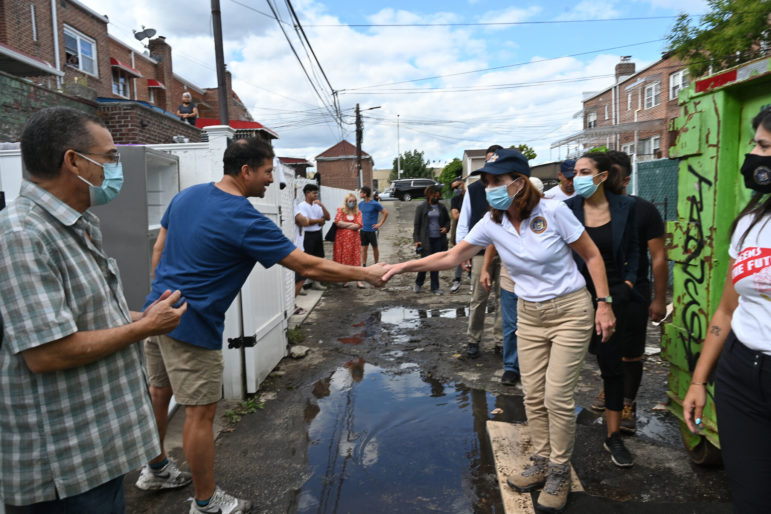
Kevin P. Coughlin / Office of the Governor
Gov. Hochul in September, touring Queens neighborhoods flooded by Hurricane Ida.In the first week of the new year and the start of the legislative calendar, New York State leaders face an opportunity to take an aggressive approach to addressing climate change and environmental issues.
On Wednesday, Gov. Kathy Hochul delivered her first State of the State address, detailing her priorities in 2022 for pandemic recovery and outlining specific pathways to make New York the renewable energy capital of the nation, and to put the state on course to achieve the goals of the Climate Leadership and Community Protection Act (CLCPA).The landmark law, passed in 2019, requires New York to greatly reduce its greenhouse gas emissions—by 40 percent before 2030 and no less than 85 percent by 2050.
“[Climate change] is a threat to our way of life here and now,” said Hochul during her speech. “That’s why we must and we will implement a vicious agenda to meet this moment.”
Among her commitments is a promise to invest $500 million in offshore wind technology, which, the agenda said, would create thousands of jobs and help fund the goal set by the CLCPA to generate nine gigawatts of energy from wind by 2035.
The investment will come as the New York State Energy Research and Development Authority (NYSERDA) prepares to launch offshore wind projects this year, which are expected to generate enough energy to power 1.5 million homes, the governor’s plan said. Hochul also announced a commitment to create an offshore wind grid and to work with federal authorities to expand wind energy, and to phase out “peaker”and older fossil fuel-generating plants.
In another shift away from fossil fuels to reduce emissions, Hochul said she’d commit to electrify school buses by 2035—a measure that was previously approved at the local level by the New York City Council—and to electrify the state’s light-duty fleet by that same year.
Since taking office in August following the ousting of former Gov. Andrew Cuomo, Hochul has demonstrated a commitment to transitioning away from fossil fuel. In September, she gave the green light to two grand-scale projects that would bring enough wind energy, hydropower and solar energy to power one-third of New York City. And under her administration, two proposed fracked-gas power plant projects were denied permits in October.
“Protecting our environment is personal to me,” Hochul said in her speech on Wednesday, recalling growing up near then-heavily polluted Lake Erie. “I was born at a time and in a place where orange smoke billowed out of the factory smokestacks, literally blocking the skies, with a horrible stench I can still recall to this day, all the while dumping toxic waste into one of the world’s largest freshwater lakes. I live surrounded by the causes of climate change. And now I’m living with the effects.”
In a bold move, Hochul also committed in the State of the State to ban natural gas hookups in new construction statewide after 2027. (This marks another agenda measure that follows New York City’s lead—the City Council voted last month to begin a similar mandate on buildings under seven stories by 2024, and on buildings taller than that by 2027.) In doing so, she pledged to achieve 2 million electrified or electrification-ready homes—at least 800,000 of them low- or moderate-income households—by 2030.
“It’s a big deal that she came out in support of a gas ban,” said Alex Beauchamp of Food & Water Watch, an environmental watchdog group. ”We haven’t done that in any state in the country.” Beauchamp added, though, that he would like to see the timeline moved up, citing proposed statewide legislation that would take effect next year.
But others were disappointed that Hochul’s agenda did not include a specific vision for funding the transition away from fossil fuels. New York Renews, a coalition of environmental groups, wants to see a $15 billion commitment in the executive budget for climate, jobs and justice.
“We cannot respond to the climate crisis with proclamations, platitudes, or pennies on the dollar,” the organization said in a statement after Hochul’s speech, adding that the governor missed an opportunity to lay out how she will fund the aggressive goals laid out by the CLCPA. “New York requires billions of dollars to best protect and invest in our communities and address the reality of climate change.”
Although Hochul’s executive budget for fiscal year 2022-2023 won’t be unveiled until later this month, the State of the State typically outlines the governor’s priorities for the year ahead.
Since the CLCPA was signed into law in 2019, advocates have pushed for a funding mechanism to ensure it will be implemented.
One such measure is the proposed Climate and Community Investment Act (CCIA), which would impose a carbon tax on heavy polluters and funnel a portion of that fund toward environmental justice communities impacted by the effects of climate change. Legislators did not bring the measure to a vote before the end of session last summer, prompting environmentalists to stage a climate funeral outside the State Capitol Building in Albany.
On Wednesday, state legislators convened again for the first time since June. They’ll have just under six months before the session ends to consider the CCIA, along with multiple other climate and environmental initiatives to meet the state’s growing focus on combating climate change.
Among the other measures up for consideration this year are the Energy Efficiency, Equity and Jobs Bill, which would require that utility companies hire individuals who are disabled, veterans, from disadvantaged communities or otherwise considered a priority population, as they make the transition to clean energy, and another measure that would regulate and reduce the environmental impact of data centers used for cryptocurrency transactions.
And later this year, voters will have an opportunity to weigh in on the Clean Water, Clean Air and Green Jobs Bond Act, which would fund improved infrastructure, flood mitigation and other climate initiatives. On Wednesday, the governor said she’d increase the multi-year investment from $3 billion to $4 billion and include an initiative to upgrade more than 1,000 under-resourced public schools.
READ MORE: On the NY Ballot: Is a Healthy Environment a Constitutional Right?
Last November, New York voters approved a ballot measure to include a right to clean water, clear air and a healthful environment in the state constitution’s bill of rights, which advocates say makes it even more crucial that state leaders take an aggressive approach to a just transition.
“Now that we have a mandated Constitutional amendment guaranteeing all residents of New York the right to clean air, clean water, and a healthy environment, our lawmakers are charged with making the law a reality for everyday folk statewide and we aim to see that they get to the work of and for the people,” said Anthony Karefa Rogers-Wright, environmental justice director of New York Lawyers for the Public Interest.



